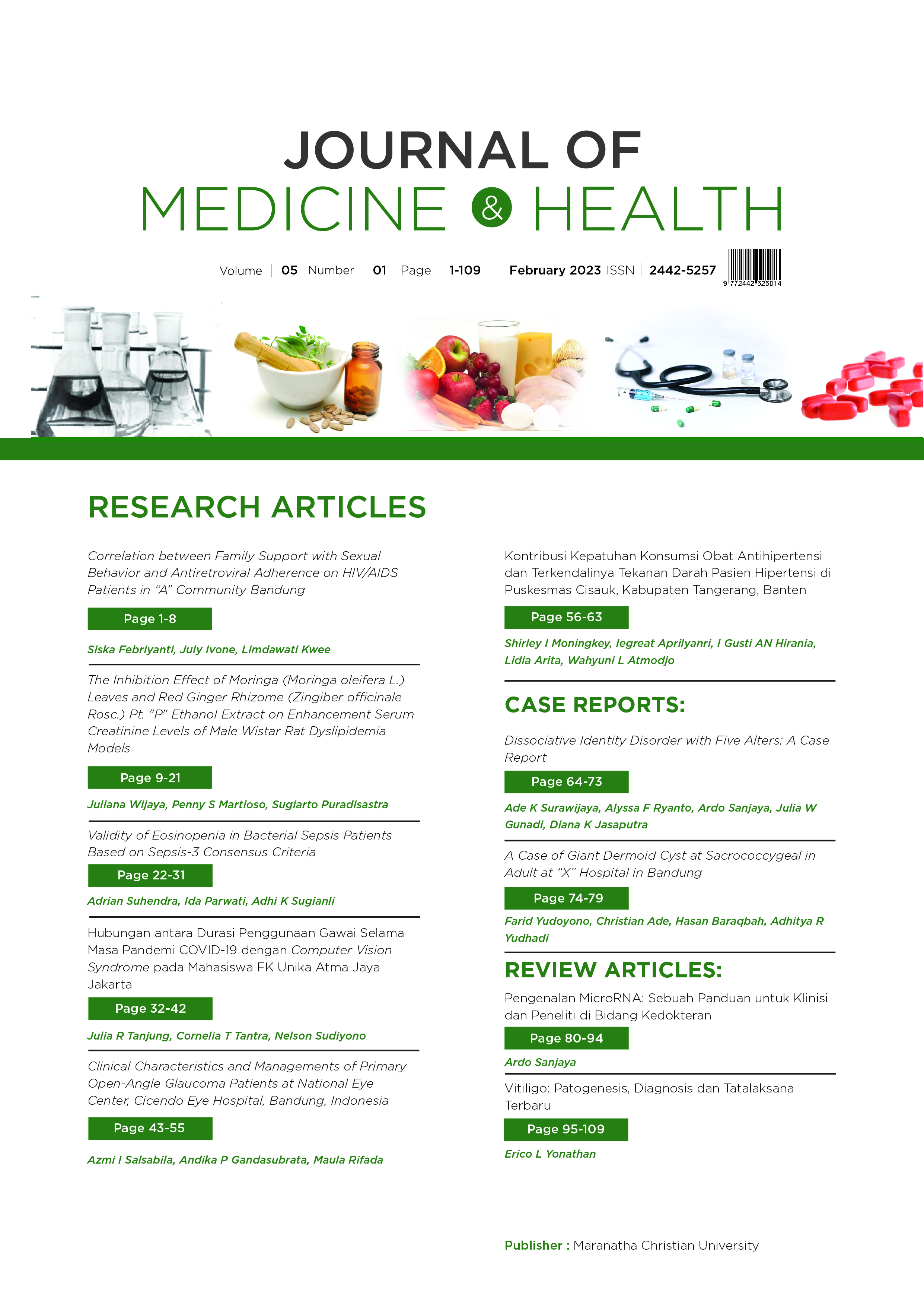Validity of Eosinopenia in Bacterial Sepsis Patients Based on Sepsis-3 Consensus Criteria
DOI:
https://doi.org/10.28932/jmh.v5i1.5351Keywords:
eosinopenia, sepsis, sepsis-3 consensus criteriaAbstract
Sepsis remains a major global healthcare problem, indicate as most frequently cause of morbidity and mortality worldwide. The last consensus of sepsis in 2016 defined sepsis as life threatening organ dysfunction caused by a dysregulated host response to infection. Dysfunction of organs can be represented by Sequential [Sepsis-Related] Organ Failure Assessment (SOFA) score. Score2 points or more consequent to the infection. Nowadays, there is ideal biomarkers of sepsis such as procalcitonin (PCT). However, the use of that markers in developing countries are hardly accessible. Eosinopenia is an prepossess biomarker because eosinophil count is always measured in daily practice and considered as a forgotten marker. The study purpose is to determine the validity of absolute eosinopenia in bacterial sepsis patients. This study is a descriptive observational study, collecting 118 patient’s medical record data from the past, diagnosed as sepsis using consensus criteria of Sepsis-3 between January 1st 2018–December 31st 2019. Eosinopenia validity test in sepsis patients showed 92.7% specificity and 71.4% sensitivity. This study also showed significant differences of absolute eosinophil count between positive sepsis patients and negative group with p value <0.001. Eosinopenia had high specificity so it could be used as a marker of diagnostic in septic patients.Downloads
References
Singer M, Deutschman CS, Seymour CW, Shankar-Hari M, Annane D, Bauer M, et al. The Third International Consensus Definitions for Sepsis and Septic Shock (Sepsis-3). JAMA. 2016;315(8):801-10.
Angus DC, van der Poll T. Severe sepsis and septic shock. N Engl J Med. 2013;369(9):840-851.
Gu X, Zhou F, Wang Y, Fan G, Cao B. Respiratory viral sepsis: epidemiology, pathophysiology, diagnosis and treatment. Eur Respir Rev. 2020; 26:200038.
Dolin HH, Papadimos TJ, Chen X, Pan ZK. Characterization of Pathogenic Sepsis Etiologies and Patient Profiles: A Novel Approach to Triage and Treatment. Microbiol. Insights. 2019; 12:1–8.
Salem MA, Ali MA, Hazem AM, Abdelsamie HS. Eosinopenia as a diagnostic marker of sepsis in critically ill patients. Egypt. J. Hosp. Med. 2018;70(6):1012-24.
Abidi K, Khoudri I, Belayachi J, Madani N, Zekraoui A, Zeggwagh AA, et al. Eosinopenia is a reliable marker of sepsis on admission to medical intensive care units. Crit. Care. 2008;12:59-65.
Shaaban H, Daniel S, Sison R, Slim J, Perez G. Eosinopenia: Is it a good marker of sepsis in comparison to procalcitonin and C-reactive protein levels for patients admitted to a critical care unit in an urban hospital? J. Crit. Care. 2010;25:570-5.
Davido B, Makhloufi S, Matt M, Calin R, Senard O, Perronne C, et al. Changes in eosinophil count during bacterial infection:revisiting an old marker to assess the efficacy of antimicrobial therapy. Int. J. Infect. Dis. 2017;61:62-6.
Anand D, Das S, Bhargava S, Srivastava LM, Garg A, Tyagi N, et al. Procalcitonin as a rapid diagnostic biomarker to differentiate between culture negative bacterial sepsis and systemic inflammatory response syndrome: A prospective, observational, cohort study. J Crit Care. 2015;30:218.e7 12.
Anand D, Ray S, Bhargava S, Srivastava LM, Garg A. Exploration of eosinopenia as a diagnostic parameter to differentiate sepsis from systemic inflammatory response syndrome: Results from an observational study. Indian J. Crit. Care Med. 2016;20(5):285-90.
Luhulima D, Hidayati W, Rejeki S, Permatasari R. Eosinopenia and Procalcitonin in Sepsis. Indones. J. Clinical Pathol. Med. Laboratory. 2013;19(2):119–25.
Sipayung E, Sembiring E, Rahimi A. Eosinopenia sebagai penanda dini diagnosis sepsis bakterialis. Majalah Kedokt Nusantara. 2015(3);48:16-9.
Zappert J. Ueber das Vorkommen der Eosinophilen Zellen in menschlichen Blute. Z Klin Med 1893, 23:227-308.
Blanchard C, Rothenberg ME. Biology of the Eosinophil. Adv Immunol. 2009; 101:81-121.
Gil H, Magy N, Mauny F, Dupond JL. Value of eosinopenia in inflammatory disorders: an 'old' marker revisited. Rev Med Interne 2003;24:431-5.
Rothenberg ME. Eosinophilia. N Engl J Med. 1998;338:1592-1600.
Bass DA, Gonwa TA, Szejda P, Cousart MS, DeChatelet LR, McCall CE. Eosinopenia of acute infection: production of eosinopenia by chemotactic factors of acute inflammation. J Clin Invest 1980, 65:1265-1271.
Aziz M, Jacob A, Yang W. Current trends in inflammatory and immunomodulatory mediators in sepsis. J.Leuko.Biol 2013;93:329-42.
Lavoignet CE, Le Borgne, Slimani H, Forato M, Kam C, Kauffmann P, et al. Relevance of eosinopenia as a marker of sepsis in the Emergency Department. Rev Med Interne. 2016;37(11):730-4.
Phua J, Ngerng WJ, See KC, Tay CK, Kiong T, Lim H, et al. Characteristics and outcomes of culture-negative versus culture-positive severe sepsis. Crit Care. 2013;17(5):R202
Downloads
Published
How to Cite
Issue
Section
License
Copyright (c) 2023 Adrian Suhendra, Ida Parwati, Adhi K Sugianli

This work is licensed under a Creative Commons Attribution-NonCommercial 4.0 International License.
Authors who publish with this journal agree to the following terms:
- Authors retain the copyright and grant the journal right of first publication with the work
simultaneously licensed under a Creative Commons Attribution-NonCommercial 4.0 International License that allows others to share the work with an acknowledgement of the work's authorship and initial publication in this journal. - Authors are able to enter into separate, additional contractual arrangements for the nonexclusive distribution of the journal's published version of the work (e.g., post it to an institutional repository or publish it in a book), with an acknowledgement of its initial publication in this journal.
 This work is licensed under a Creative Commons Attribution-NonCommercial 4.0 International License.
This work is licensed under a Creative Commons Attribution-NonCommercial 4.0 International License.

















